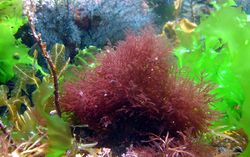Difference between revisions of "Pollution and algae"
| Line 5: | Line 5: | ||
Algae are known to accumulate both [[heavy metals]] and [[organochlorine compounds]]. <ref>Elliot, M.; Hemingway, K. (2002). Fishes in estuaries. Blackwell Science: London, UK. 636 pp.</ref> Heavy metals can depress algal growth when they are present above a certain threshold level. They can also destabilize their cell membrane, which inhibits cell division or causes the algae to change shape. <ref>Md. Shahidul Islam and Masaru Tanaka, 2004, Impacts of pollution on coastal and marine ecosystems including coastal and marine fisheries and approach for management: a review and synthesis, Marine Pollution Bulletin Volume 48, 7-8 Pages 624-649.</ref> | Algae are known to accumulate both [[heavy metals]] and [[organochlorine compounds]]. <ref>Elliot, M.; Hemingway, K. (2002). Fishes in estuaries. Blackwell Science: London, UK. 636 pp.</ref> Heavy metals can depress algal growth when they are present above a certain threshold level. They can also destabilize their cell membrane, which inhibits cell division or causes the algae to change shape. <ref>Md. Shahidul Islam and Masaru Tanaka, 2004, Impacts of pollution on coastal and marine ecosystems including coastal and marine fisheries and approach for management: a review and synthesis, Marine Pollution Bulletin Volume 48, 7-8 Pages 624-649.</ref> | ||
| − | Organochlorine compounds can also inhibit photosynthesis and algae cell growth. However, there seems to be a wide range in the tolerance of algae towards these compounds. Some species are affected at lower concentrations than other algae species. Therefore these compounds might influence the algae community structure, and thus threaten the algae biodiversity and | + | Organochlorine compounds can also inhibit photosynthesis and algae cell growth. However, there seems to be a wide range in the tolerance of algae towards these compounds. Some species are affected at lower concentrations than other algae species. Therefore these compounds might influence the algae community structure, and thus threaten the algae biodiversity and their seasonal cycles. <ref>https://kb.osu.edu/dspace/bitstream/1811/5666/1/V72N01_006.pdf</ref> |
Below you can find some links to Belgian case studies on ecotoxicology in algae. | Below you can find some links to Belgian case studies on ecotoxicology in algae. | ||
Revision as of 16:43, 22 July 2009
Algae are known to accumulate both heavy metals and organochlorine compounds. [1] Heavy metals can depress algal growth when they are present above a certain threshold level. They can also destabilize their cell membrane, which inhibits cell division or causes the algae to change shape. [2]
Organochlorine compounds can also inhibit photosynthesis and algae cell growth. However, there seems to be a wide range in the tolerance of algae towards these compounds. Some species are affected at lower concentrations than other algae species. Therefore these compounds might influence the algae community structure, and thus threaten the algae biodiversity and their seasonal cycles. [3]
Below you can find some links to Belgian case studies on ecotoxicology in algae.
Case studies
Case study 1:PCBs and organochlorine pesticides in Antarctic algae[4]
References
- ↑ Elliot, M.; Hemingway, K. (2002). Fishes in estuaries. Blackwell Science: London, UK. 636 pp.
- ↑ Md. Shahidul Islam and Masaru Tanaka, 2004, Impacts of pollution on coastal and marine ecosystems including coastal and marine fisheries and approach for management: a review and synthesis, Marine Pollution Bulletin Volume 48, 7-8 Pages 624-649.
- ↑ https://kb.osu.edu/dspace/bitstream/1811/5666/1/V72N01_006.pdf
- ↑ Joiris, C.R.; Overloop, W. (1991). PCBs and organochlorine pesticides in phytoplankton and zooplankton in the Indian sector of the Southern ocean. Antarctic Science 3: 371-377
